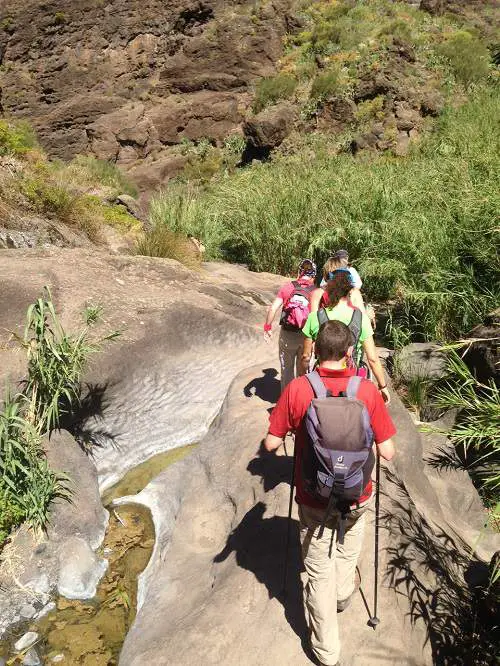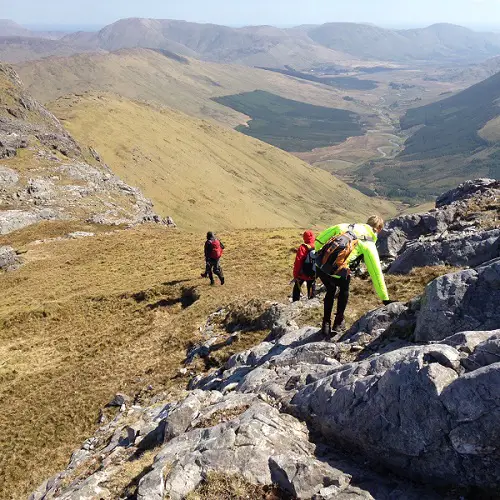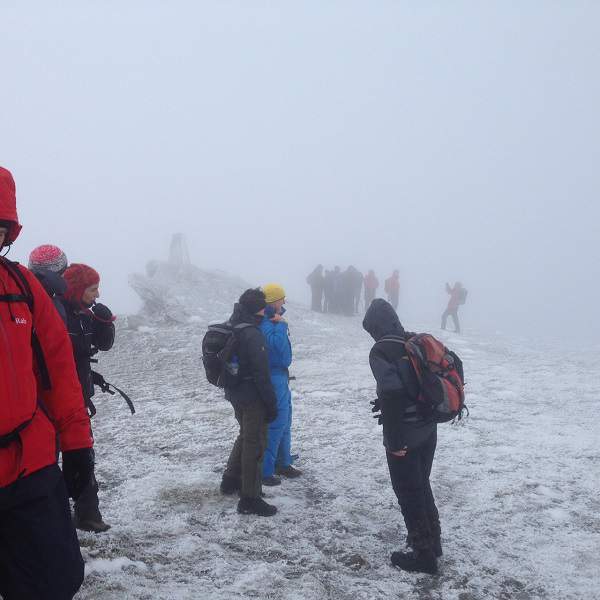Today’s post is a short one on a simple tip to help keep a large hiking group together when out hiking with a group of folks of differing hiking capability levels or if, for whatever reason, they tend to split up.

Invariably, when I go out hiking I go out either:
- On my own
- With a group of friends
- With a hiking club – many of these folks are friends too but there are always new hikers on these hikes
A regular problem that can occur in larger hiking groups is that the group can easily split as the hike progresses. As people hike some will get to chatting, some are just more fit than others and so on.
Inevitably, a gap opens up and the main job of the group leader is to make sure that the gap doesn’t get so wide as to become unmanageable to the point where one part of the group can’t locate the other.
Before looking at a simple way to prevent this problem from developing, let’s take a closer look at what I mean by the last two categories listed above. Hiking on my own is pretty self-explanatory and not relevant here so I think we can skip that one and move straight to hiking with a group of friends.
Hiking with Friends
Looking at the second group first, when I hike with what I class as my hiking friends, they are all experienced hikers and people I hike with regularly.
We move very fast and so everyone is very fit and well able to hike anywhere from 20 or 40 kms on a typical day hike. This kind of hiking is well above average and would border on, if not qualify as, challenge / ultra-hiking i.e. taking in big distances at a very fast pace.

We all know each other through various other hiking groups and so know we can keep the pace so there is never an issue of us keeping together. Although, even within this group, there are some of the guys who leave me well behind 🙂 They have that extra gear or two when it comes to speed. However, that’s not an issue in this group as we are all experienced hikers.
When we head out we are usually in a group of anywhere from two to ten, never more than that. Someone usually takes the lead for a particular hike but it isn’t formal as such, just if someone has a route idea, we just head along and see how we get on.
Therefore, with the above points in mind, people are well able to look after themselves when it comes to finding their way around. We all have the appropriate gear and are all reasonably good at navigation and so on, so if we get split up because some folks want to break off at a faster pace, or even break into a run, that’s not an issue. We will all see each other at the finish point.
Hiking with My Hiking Club
Now, when I go out hiking with a club I hike with regularly, it’s a much more formal affair. Firstly, there are nominated leaders. This has to be the case as there are always new people coming along so a lot more planning and checking needs to be done.
It is not uncommon for people to try and sign up for hikes that are not within their fitness level or people to show up with the wrong gear for a particular type of hike.
It’s also not uncommon for people to vastly over rate their fitness level, without having done any kind of assessment. If someone isn’t regularly active, there are ways you can assess your fitness to get an idea of where you are at before you head out on a long hike.
All of these type of things could of course lead to problems so a lot more vigilance and policing is required. These hikes are also much bigger in terms of numbers and so will be anywhere from fifteen to thirty people. The number of leaders and support of course increases as the numbers rise.
There will always at least be a leader, leading the way on the route, and usually a back-marker i.e. someone who shepherds everyone from the rear and keeps an eye on the group to be sure no-one strays and, ideally, avoid large gaps from developing.
This can of course be harder to monitor in bad weather though, when visibility levels aren’t good. See the image below of a hike I was on earlier this year. The group in the distance was part of our hiking group too, they’re not really that far away but the weather makes it much harder to see them. A few feet or meters more and they’d be out of view for sure.

All of these hikes are also graded. That means that as much as possible is done to ensure that people do not take on hikes they are not able for.
Most hiking groups insist on newbies starting on a few lower grade hikes so the group leaders can get a feel for the persons fitness.
The person can then quickly upgrade quickly to a higher level hike if they are really fit already as that will be evident on their first time out.
It’s worth noting that if you have just came back from climbing the Matterhorn in the Alps, most hiking groups, although not all, will give you a waiver from doing the lower graded hikes, if they’re satisfied you’re fit enough and have the experience etc.
While grading hikes is a very good and logical thing to do, it still doesn’t prevent the group from splitting up on the trail. So, when you have this kind of bigger hiking group, it can be very easy for one or more large gaps to form. As mentioned at the start of this post, this can be for any number of reasons.
People get yakking and so slow down a bit more; some are fitter than others and want to push at a harder pace; some aren’t feeling too hot after a late night in the bar the previous evening 🙂 there are many possible reasons but those are some common ones.
What can you do?
There is an easy thing you can do when you have a big hiking group and you don’t want the group to split out into smaller groups. That is to simply put the slowest people at the front.
The main pros of this is that most other people in the group, even if they’re yakking about the football game last night, will likely be more than capable of keeping pace with the slowest folks in the group. Therefore, you should cut down the odds, of the group splitting up, down significantly.
This is easy peesy!
But wait, there is a downside 🙂 When you employ this tactic in a large group, while you may stop the group from splitting up, you will quite likely aggravate a large proportion of the group who would prefer to hike faster. If they are constantly having to reel their pace in to stay in line with slower folks at the front, they will not be happy and so quite possibly not enjoy the hike.
Conclusion
In conclusion, I think, as with most things, using this tactic is a trade off. Ideally the grading of your hikes caters for this problem and so even when you put the slower people in a large group at the front, it should more or less be at a pace that is challenging enough but comfortable for everyone else.
Gaps, will always inevitably form at some point but if it’s a fine day and you have good visibility, providing there are regular enough stops to provide the group the opportunity to coral together again, you should be fine.
However, if you do get into a situation though where you need to keep a large group much tighter, say in dense fog or any bad visibility, putting the slowest people up front alongside the leader and issuing a strict instruction to everyone else to stay behind and in touch with the lead group, should go some way to making life a little bit easier.
If you find yourself in this type of situation, the absolute last thing you want is the group splitting and people drifting off on their own. Rather than being able to concentrate on navigating your way out of a tricky situation, you will have to come up with some way to locate your wayward hiking colleagues which will not be fun in near zero visibility.
I hope you found this short post and tip useful. Please share it around your social networks if you did. Do you have any other hiking tips for keeping a large hiking group together when out on the trail? I’d love to hear about them in the comments below.